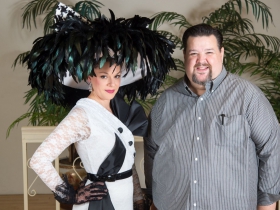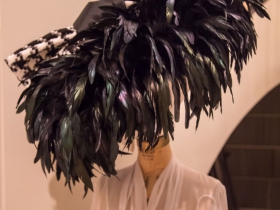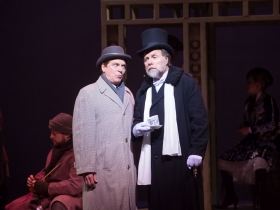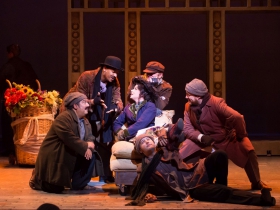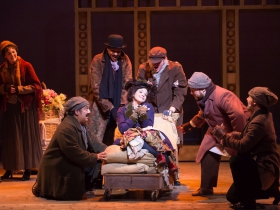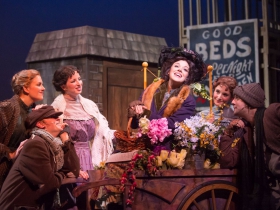Moses Scales the Mountain
Skylight’s sparkling staging of ‘My Fair Lady” paced by Norman Moses’ unforgettable Henry Higgins.
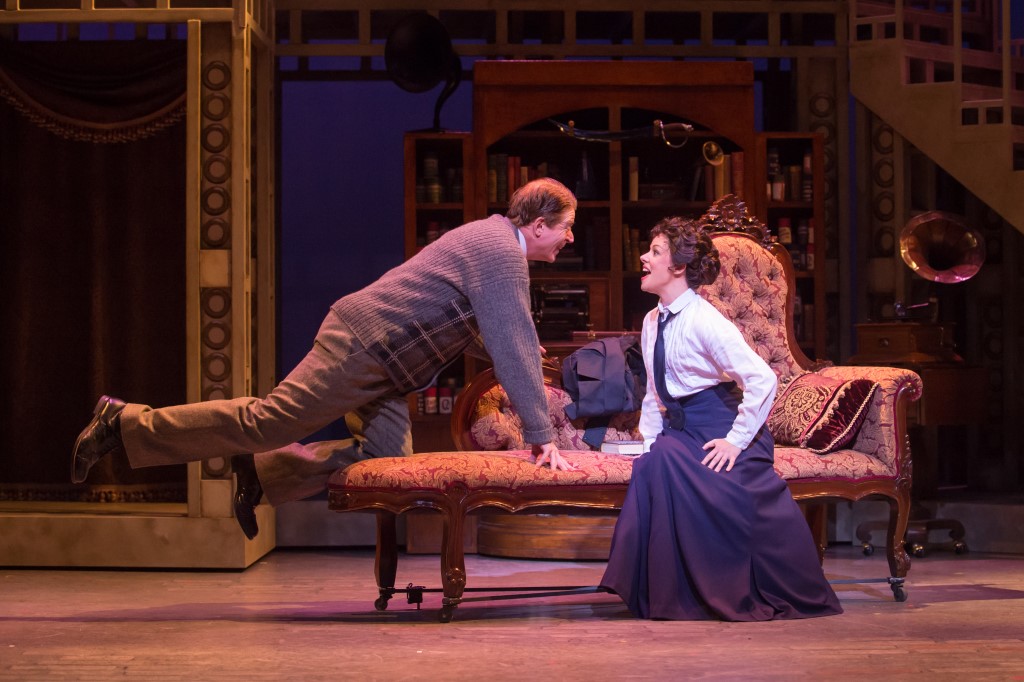
Skylight My Fair Lady Highlights: Norman Moses (Henry Higgins) and Natalie Ford (Eliza Doolittle). Photo by Mark Frohna.
Almost inarguably since its Broadway premiere in 1956, My Fair Lady has been regarded as the pinnacle achievement of the American musical, with memorable characters and culturally rich dialog from the George Bernard Shaw play and Gabriel Pascal’s “Pygmalion” film. These were refashioned in smart style by Alan Jay Lerner (lyrics) and Frederick Loewe (music) into a score to die for, with still definitive staging by Moss Hart and unforgettable design by Cecil Beaton.
Countless productions have tried to live up to or re-interpret the model. Few in nearly 60 years have put in as much care, muscle, affection and musicality as the Skylight Music Theatre’s production, through December 27 at the Cabot Theatre in the Broadway Theatre Center. It’s the guaranteed family fare winner in the holiday musical comedy sweepstakes.
But patrons have to embrace it as a proscenium operetta played out to the house and delighting in impaling you to the back row with its show-stopping voices, energetic chorus turns by a tireless dozen, sailing sets, visual dazzle in countless costume tableaus and a perfectly coordinated score that washes over you through music director Shari Rhoads and a solid 13-piece pit orchestra.
Rather than the full values of developing characters in a real battle of wills and class status, the conflict unfolds through director Dorothy Danner’s skillful but constantly busy hands telling us in stunning detail where our emotions should be. In case one of the cast might slide past a funny moment or the patron doesn’t grasp the speedy cleverness of the lyrics, props pop up from hidden crevices and underlining gestures tell us all.
There is an exception who can adroitly work every prop device into his full character creativity. That’s Norman Moses as Prof. Henry Higgins, smoothly moving the musical along through his own vision, with few fallbacks on the conventional takes that surround the role. Higgins, for those who have been sleeping since 1956, is the gent so high-bred he can ignore breeding, a self-absorbed phonetics expert and confirmed woman hater who is going to get a curious lesson in humility from his Cockney gutter pupil rising to grand ballroom entrance and her own maturity, Eliza Doolittle.
Many Milwaukeeans have seen Moses rely on his stage charm, warm singing voice and vaudevillian instincts for 35 years. To them this will be a Moses reborn into the top heap of the dozens of Higgins I’ve seen going back to the Broadway and road originals.
Occasionally the staging forces him into a familiar studied response but he is so focused on giving drive and insight to the irascible egotistical Higgins that every line and lyric opens up. The actor’s energy is specifically at the character’s service. This is quite a feat, since so much of what Higgins says to Eliza would raise hackles among today’s feminists but comes across as charmingly and irresistibly direct. The performance relies on establishing Higgins and then weaving in new revelations, much like “I’ve Grown Accustomed to Her Face” advances motifs first heard in “I’m an Ordinary Man.”
It is somewhat surprising to single out Higgins. Most of the praise would normally go to this Eliza. You could not find a better big voiced versatile soprano and more attractive appearance and manner than Natalie Ford, whose proper enunciation and screeching EOwwws are impeccably rendered.
That’s the reason this musical is placed on the mountain top. The show should be built around Eliza’s journey more than Higgins’ thaw. The marvelous songs revolve on that, not just beautiful singing but rounded artistic weight. The mesmerizing elements of Shaw’s straight play remain. The musical Eliza should be emotionally engaging. Ford comes far closer when the second act lets her tear more directly into Higgins, but we are watching her skill more than sharing her development. Moses gives us both.
None of this suggests the audience isn’t fully attentive for all three hours. This is a demanding technical piece in any case and director Danner flies in sets, costumes and ensemble with such skill and speed that the eye is never droopy and the intention is never subtle.
Some of the character work is solidly appealing and smartly underplayed, notably Rick Richter as a fine Colonel Pickering and Carol Greif as a sympathetic housekeeper. Tom Mulder has the always thankless role of swooning swain Freddy Eynsford-Hill, rescued by also having the most famous song, “On the Street Where You Live,” sung in powerful tenor with absolutely no real feeling for Eliza, just for the high notes.
The ensemble is constantly switching costumes, moving sets and anchoring chorales and solos. The prim household staff converts into buskers, swells and boozers, and such versatility deserves appreciation.
The handling of the various dialects has been pummeled into accuracy by dialect coach Raeleen McMillion, and it’s understandable that the songs involving Eliza’s father (“Little Bit of Luck,” “Get Me to the Church on Time”) become eruptions of ensemble whoopee. As Alfred P. Doolittle, Joel Kopischke seems to switch register in the first line of every song, not unusual in the vocal demands of this role, but his dancing feet and barely concealed mirth win the crowd with pure energy.
Some of the scenes are intentionally inbred opportunities for gorgeous looks and sounds. The original makers well understood the importance of spectacle turning back onto the characters. The merriment in how scenic designer Stephen Hudson-Mairet’s multiple sets fly in and out matches the choreographic romps concocted by Pam Kriger. Deliberately out-vamping Beaton in the hysterical high hats and refined excitement of the Ascot races, costume designer Chris March enriches the visual pull of the enterprise.
Moses remains the standout with his relish for nuance and connectivity. That’s the standard to aim for in more than 30 Skylight performances still to accompany the grand fun already there in My Fair Lady.
My Fair Lady Gallery
Review
-
Eating Burmese in Bay View
 Dec 13th, 2025 by Cari Taylor-Carlson
Dec 13th, 2025 by Cari Taylor-Carlson
-
Casablanca Is a Milwaukee Success
 Nov 30th, 2025 by Cari Taylor-Carlson
Nov 30th, 2025 by Cari Taylor-Carlson
-
Oh, Those Witty 18th Century Brits
 Nov 24th, 2025 by Dominique Paul Noth
Nov 24th, 2025 by Dominique Paul Noth
Theater
-
Oh, Those Witty 18th Century Brits
 Nov 24th, 2025 by Dominique Paul Noth
Nov 24th, 2025 by Dominique Paul Noth
-
Skylight’s Holiday Show Is Lots of Fun
 Nov 16th, 2025 by Dominique Paul Noth
Nov 16th, 2025 by Dominique Paul Noth
-
Rep’s ‘Come From Away’ Is a Triumph
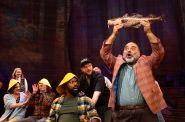 Nov 10th, 2025 by Dominique Paul Noth
Nov 10th, 2025 by Dominique Paul Noth

